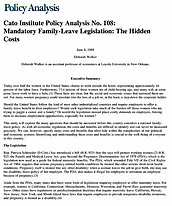Should the United States follow the lead of most other industrialized countries and require employers to offer a family-leave benefit to their employees? Would such legislation take much of the burden off those women who are trying to juggle a career and a family? Or would the legislation instead place costly demands on employers, forcing them to decrease employment opportunities, especially for women?
This study will explore the many questions that should be answered before this country considers a national family-leave policy. As with all economic regulation, the costs and benefits are difficult to identify and can never be measured precisely. We can, however, specify many costs and benefits that often hide within the complexities of our political and economic systems. Identifying and understanding these costs and benefits is crucial to the well-being of everyone in this country.

